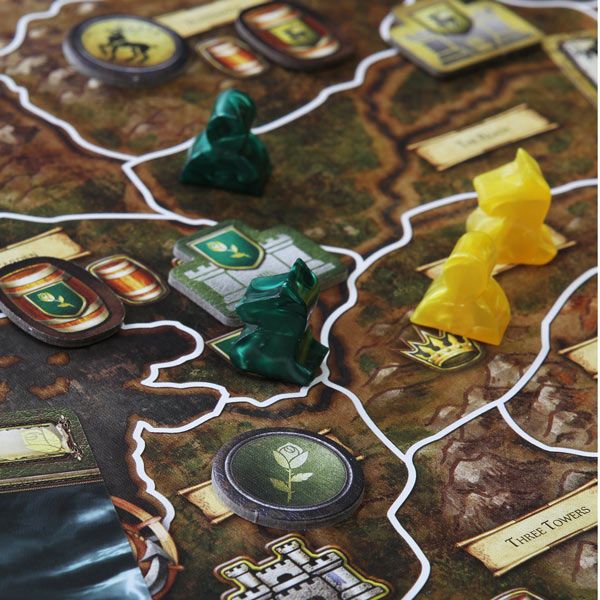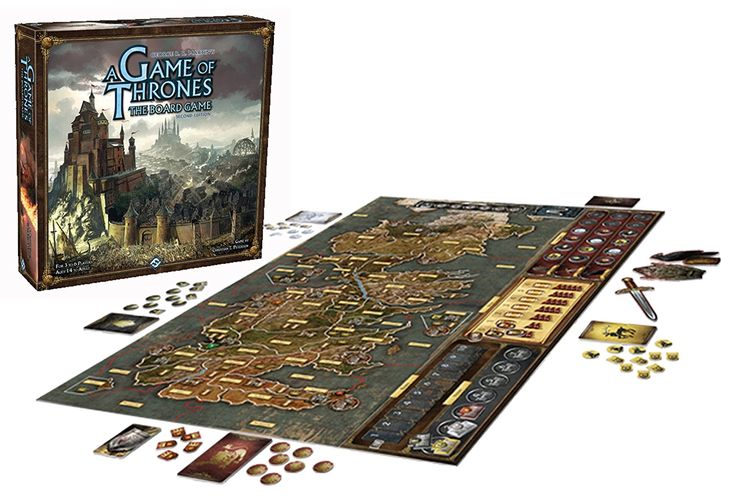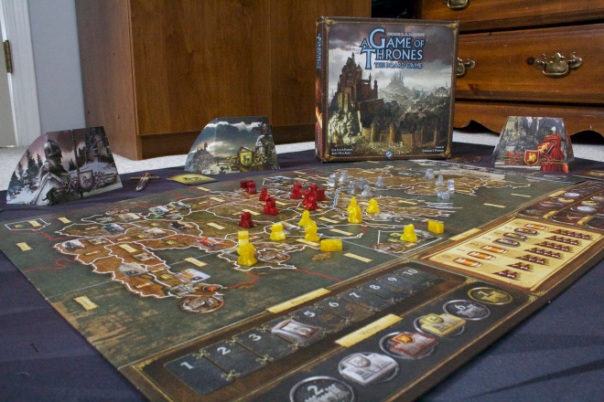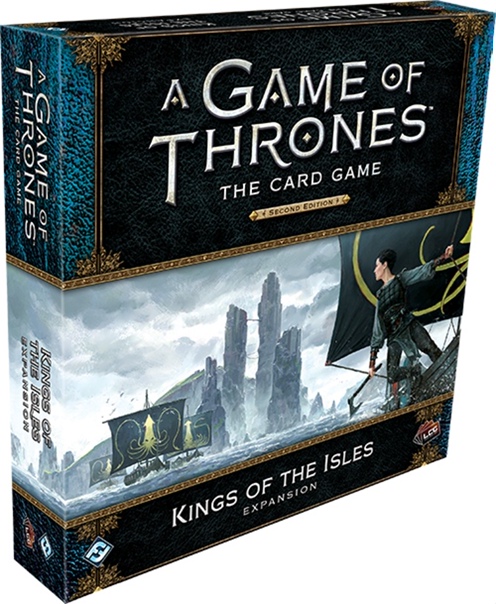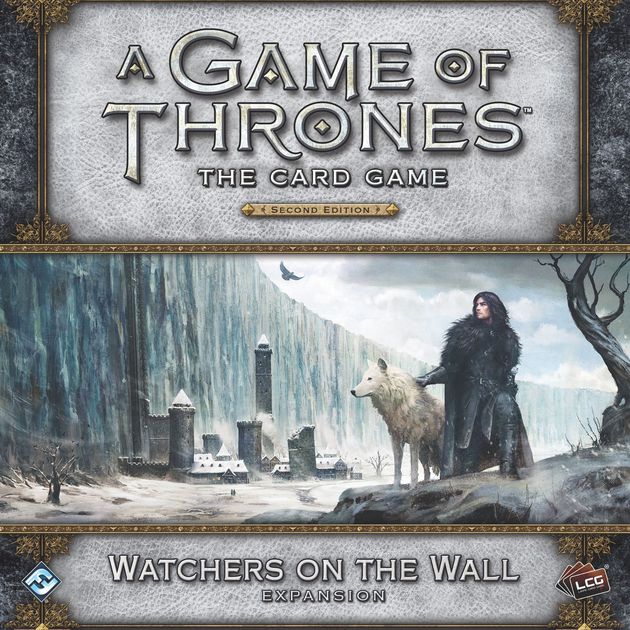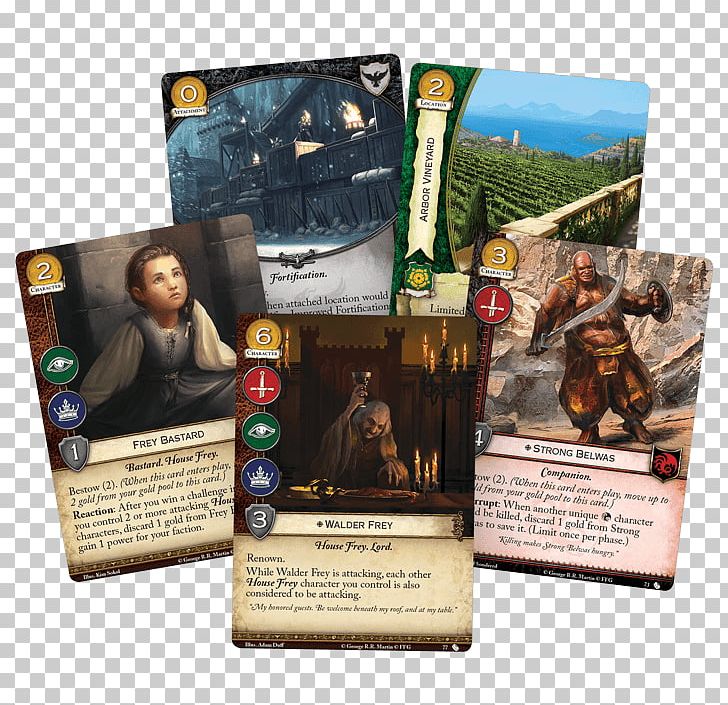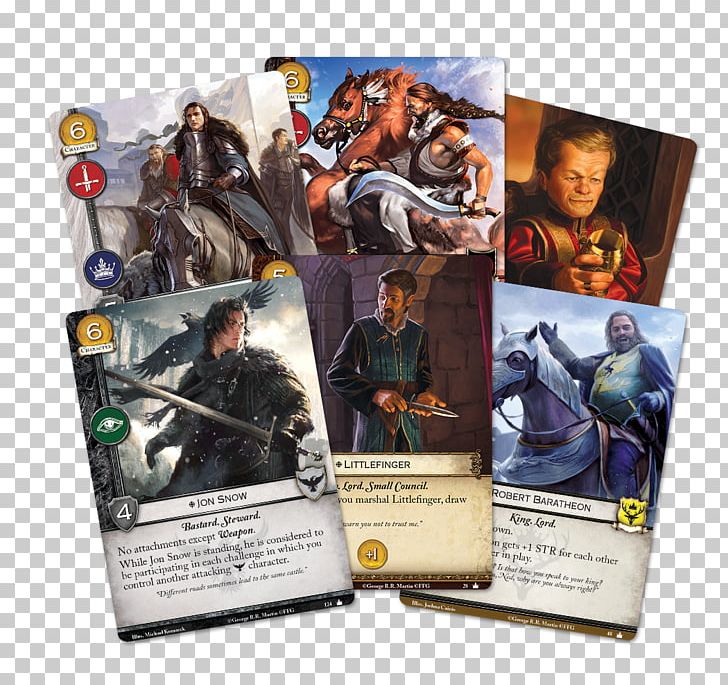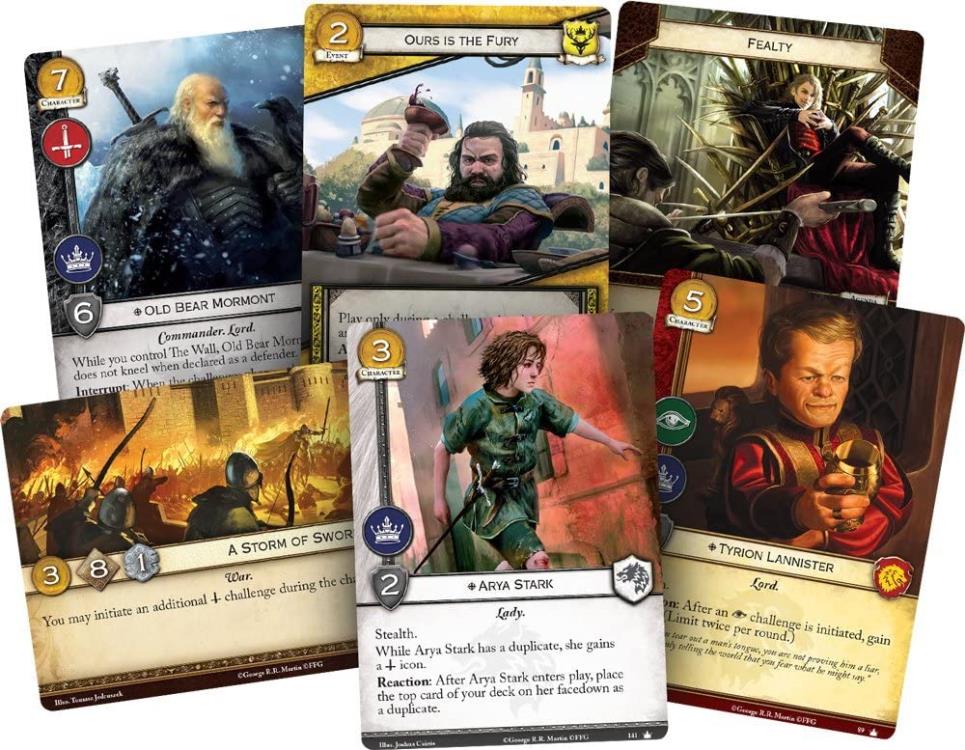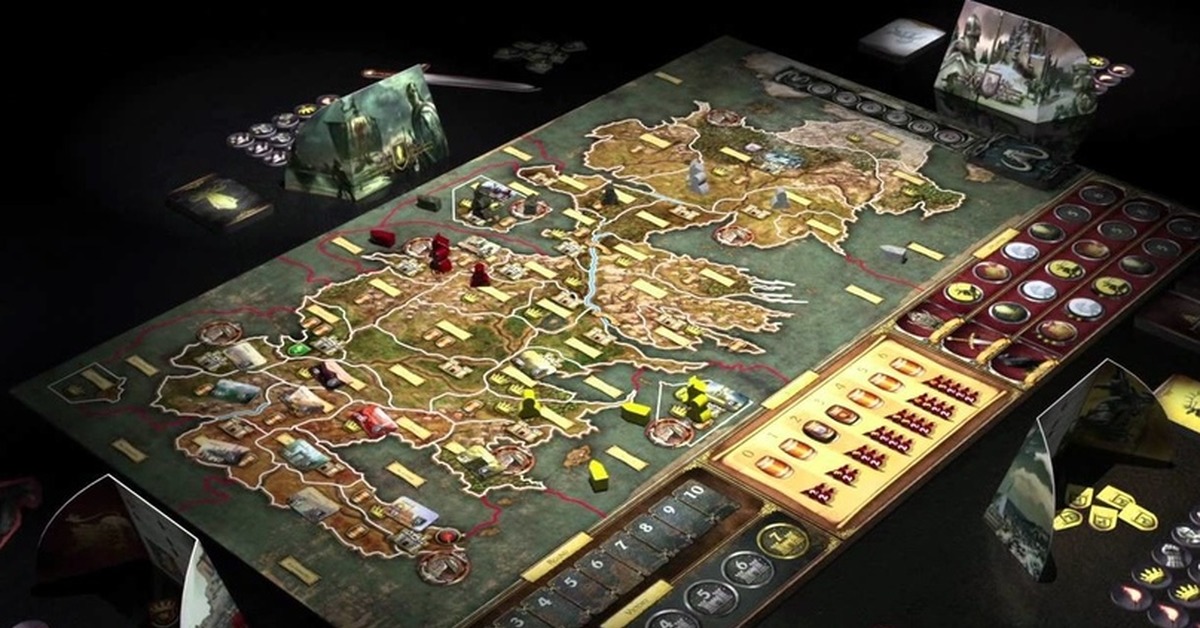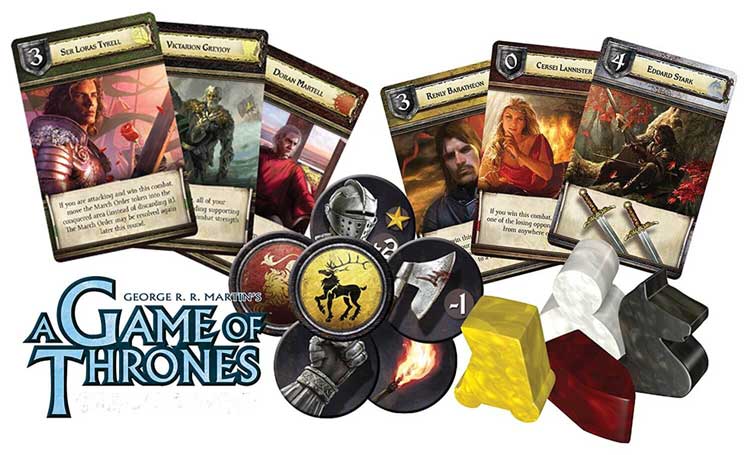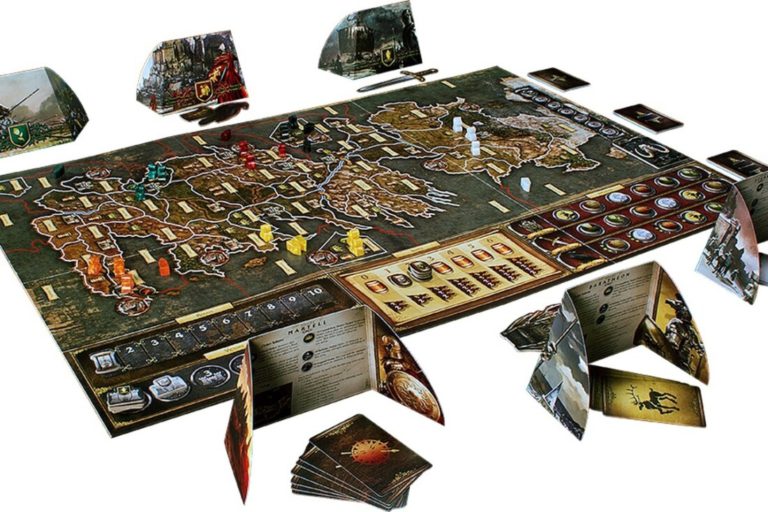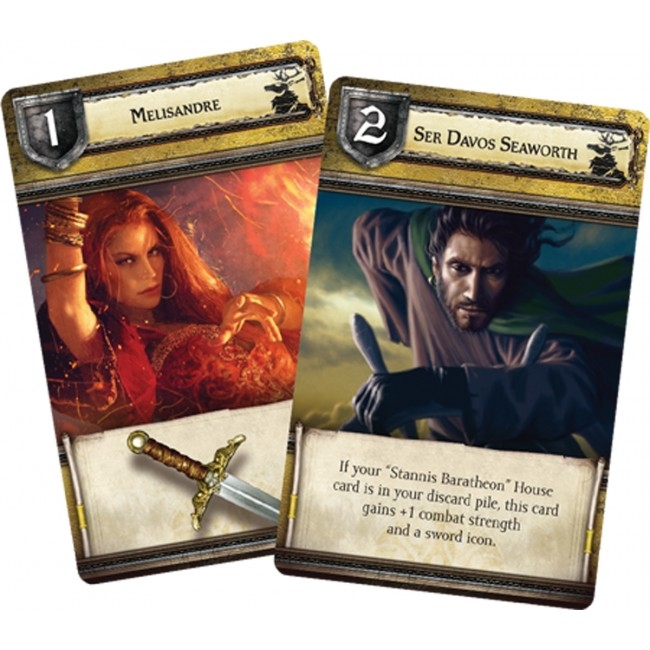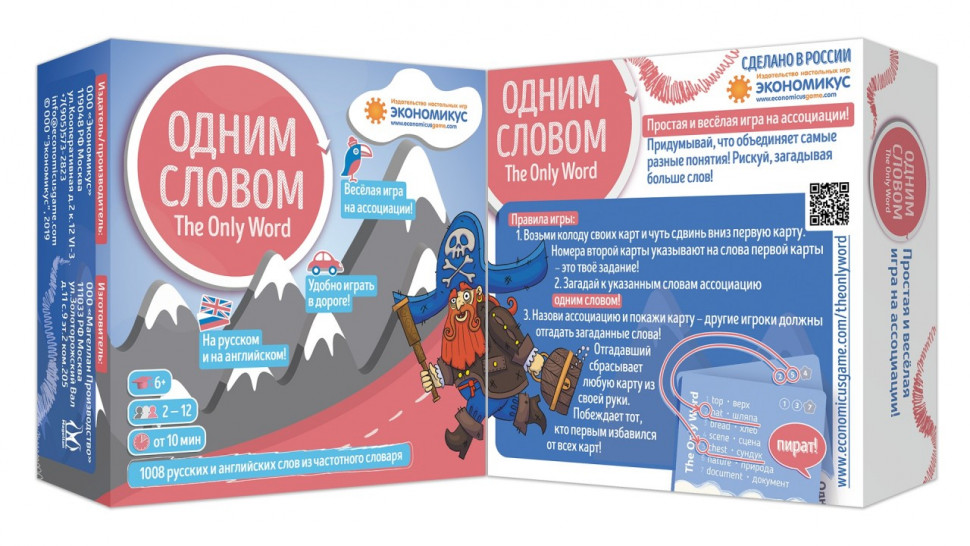World Champion Lists
Recent News
31 Jan 2020
Star Wars: X-Wing Second Edition
FFG Live in February
Take a Look at Upcoming FFG Livestreams
13 Jan 2020
A Game of Thrones: The Card Game
Take the Black
A New FAQ for A Game of Thrones: The Card Game
All news
The copyrightable portions of A Game of Thrones: The Card Game Second Edition is 2015 Fantasy Flight Publishing, Inc. Licensed by George R.R. Martin. The names, descriptions, and depictions applied to this game are derived from works copyrighted by George R.R. Martin, and may not be used or reused without his permission. A Game of Thrones: The Card Game Second Edition, its expansion titles, Living Card Game, LCG, the LCG logo and Fantasy Flight Supply are trademarks and/or registered trademarks of Fantasy Flight Publishing, Inc. All rights reserved to their respective owners.
World Champion Lists
Recent News
31 Jan 2020
Star Wars: X-Wing Second Edition
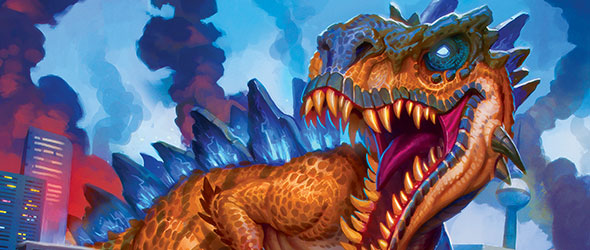
FFG Live in February
Take a Look at Upcoming FFG Livestreams
13 Jan 2020
A Game of Thrones: The Card Game

Take the Black
A New FAQ for A Game of Thrones: The Card Game
All news
The copyrightable portions of A Game of Thrones: The Card Game Second Edition is 2015 Fantasy Flight Publishing, Inc. Licensed by George R.R. Martin. The names, descriptions, and depictions applied to this game are derived from works copyrighted by George R.R. Martin, and may not be used or reused without his permission. A Game of Thrones: The Card Game Second Edition, its expansion titles, Living Card Game, LCG, the LCG logo and Fantasy Flight Supply are trademarks and/or registered trademarks of Fantasy Flight Publishing, Inc. All rights reserved to their respective owners.
Military, Intrigue, and Power
“This child king commands the wealth of Casterly Rock and the power of Highgarden. He has the Boltons and the Freys.” Lord Godric rubbed his chin. “Still … in this world only winter is certain. Ned Stark told my father that, here in this very hall.”
–George R.R. Martin, A Dance with Dragons
Inevitably, you and your opponents must clash as your Great Houses struggle to gain power. After choosing plots and drawing cards, all players have the chance to marshal new characters, locations, and attachments, mustering your fleets on the Iron Isles or calling your banners to Sunspear. After marshaling, you clash with other claimants to the Iron Throne! You can challenge your opponents on the field of battle, in back-alley intrigue, or in the political arena. There are three distinct challenge types in A Game of Thrones: The Card Game Second Edition.
A military challenge allows your warriors and armies to face your opponent’s forces in pitched battle. If you win a military challenge against your opponent, he must choose and kill a number of characters equal to the claim on your revealed plot card. Killed characters are placed in a dead pile, and unique characters cannot be played while they have a copy in the dead pile.
Intrigue challenges pit your schemers, assassins, and spies against your opponent in shadowy manipulation and subterfuge. If you win an intrigue challenge against your opponent, he must randomly discard a number of cards from his hand equal to your claim, reducing his options for future turns. If you can win enough intrigue challenges against your opponent, you can substantially reduce his ability to fight back against your forces.
Power challenges enable your most influential characters to undermine your opponent’s political position and increase your own. If you win a power challenge against your opponent, you move power tokens equal to your claim value from his faction card to your own. Power challenges are one of the principal ways for you to come closer to victory and the Iron Throne.
You can initiate a challenge by kneeling one or more of your characters, and your opponent can respond by kneeling character to defend. A character must bear the corresponding challenge icon to be declared as an attacker or defender in a challenge. You also have the chance to affect the outcome of a challenge by using special abilities and playing event cards. An unexpected tactic or sudden assassination may turn the tide of the challenge abruptly in your favor! After both players have decided to pass on the opportunity to take more actions, the side with the higher total STR is victorious.
Every character in the game bears a certain amount of Strength, or STR, and the variables of STR and challenge icons give tremendous variety to the characters that support your claim to the Iron Throne. For example,
Eddard Stark
(Core Set, 144) has a STR of five and the military and power challenge icons. Eddard Stark features a high STR, but because he lacks the subtlety to possess an intrigue challenge icon, a single spy may slip right past him for an unopposed intrigue challenge. How you choose to challenge your opponent and which characters you commit to your attacks and defense are the principal ways you may gain superiority and victory in A Game of Thrones: The Card Game Second Edition.
The Tournament Begins
“The splendor of it all took Sansa’s breath away; the shining armor, the great chargers caparisoned in silver and gold, the shouts of the crowd, the banners snapping in the wind…and the knights themselves, the knights most of all.”
–George R.R. Martin, A Game of Thrones
A Game of Thrones: The Card Game Second Edition gives you the chance to battle for the Iron Throne in two unique game experiences. Two players can enter the lists to engage in a joust, fighting honorably for the glory of victory, or multiple players can partake in a chaotic and ferocious melee, adding new levels of treachery and backstabbing to the game. With a single Core Set of A Game of Thrones: The Card Game Second Edition, you can play a four-player melee, but with two or more Core Sets, you can play a melee with up to six players.
When you play a melee game of A Game of Thrones: The Card Game Second Edition, every player takes his place in the king’s Small Council by selecting a title. These titles come with pre-existing allegiances and enmities. If your chosen title supports another player’s title, you cannot challenge this player, although he is under no such restriction! If your title opposes another player’s title, you receive a bonus power token the first time you win a challenge against that player. Every title also confers a specific advantage to the player who selects it, drawing you deeper into the world of Westeros and granting you the tools to subvert your opponent’s plans.
In the diagram above, green arrows show a title’s support and red arrows show which titles oppose each other.
You and your opponents return your titles and select new ones at the beginning of each round, so as the game continues, you will bear many different titles, shifting your allegiances in whichever way brings you closest to the Iron Throne!
World Champion Lists
Recent News
31 Jan 2020
Star Wars: X-Wing Second Edition

FFG Live in February
Take a Look at Upcoming FFG Livestreams
13 Jan 2020
A Game of Thrones: The Card Game

Take the Black
A New FAQ for A Game of Thrones: The Card Game
All news
The copyrightable portions of A Game of Thrones: The Card Game Second Edition is 2015 Fantasy Flight Publishing, Inc. Licensed by George R.R. Martin. The names, descriptions, and depictions applied to this game are derived from works copyrighted by George R.R. Martin, and may not be used or reused without his permission. A Game of Thrones: The Card Game Second Edition, its expansion titles, Living Card Game, LCG, the LCG logo and Fantasy Flight Supply are trademarks and/or registered trademarks of Fantasy Flight Publishing, Inc. All rights reserved to their respective owners.
Plot Your Victory
“You should thank the gods that Varys the Spider is a part of this plot of yours.”
–George R.R. Martin, A Dance with Dragons
To win your way to the Iron Throne, you must command the characters that flock to your banner, but you must also weave cunning plots to shape the future of Westeros. To this end, you use two distinct decks: a plot deck and a player deck. The player deck contains the characters, locations, attachments, and events that you hold in your hand, marshal into play, and use to defeat your opponents and claim power for your faction. The plot deck, on the other hand, consists of seven carefully chosen plot cards, which represent schemes, tricks, and maneuvers that you may use to gain the upper hand in a game round.
The plot deck is not shuffled like your player deck. Instead, you must consider your available plots at the beginning of each round and select a new plot, forming a plan for how you will win your way closer to the Iron Throne. Your plot sets the rest of your plans in motion, determining your income for the round, your initiative value, how powerful your challenges will be, and how many cards you can keep in your hand at the end of the round. Your plot may also have a special effect that triggers immediately or persists throughout the round.
For example, as your plot, you may select
Wildfire Assault
(Core Set, 26). This plot has an income value of four, giving you four gold dragons to spend marshaling characters, locations, and attachments, and playing events for the rest of the round. Wildfire Assault also has an initiative value of seven. The player with the highest initiative value selects which player will play first for the round. The third number on the plot card is the claim value, which determines the power of your challenges, as we’ll explore below. Wildfire Assault also has a reserve value of six, meaning that at the end of the round, you must discard down to six cards. Finally, Wildfire Assault bears the text, “When Revealed: Each player chooses up to 3 characters he or she controls. Kill each character not chosen (cannot be saved.)” A deadly hail of wildfire can quickly thin the amount of characters in the game.
Because you can choose any unused plot in your plot deck at the beginning of a round, a well-constructed plot deck gives you tremendous flexibility to repel your opponent or seize the power you need to secure your claim to the Iron Throne. The best schemers in A Song of Ice and Fire always have plans within plans, and your plot deck gives you the chance to be just as prepared.
Call Your Banners
“Martell brings some formidable companions, it would seem. Not one of the houses Pod had named was small or insignificant. Nine of the greatest lords of Dorne were coming up the kingsroad, them or their heirs, and somehow Tyrion did not think they had come all this way just to see the dancing bear.”
–George R.R. Martin, A Storm of Swords
You’ll take control of numerous factions in A Game of Thrones: The Card Game Second Edition. Each faction offers a unique playstyle, allowing you to call upon new tricks and tactics in any deck you play. You may command a longship with Asha Greyjoy or follow Syrio’s training with Arya Stark. You may safeguard the princes of Dorne with Areo Hotah. You may even pledge your strength to Tywin Lannister and support the lions’ claim to the Iron Throne!
Faction cards are double sided: the front is the main faction card, while the reverse side is an agenda that allows you to include non-loyal cards of that faction in another deck.
A starter deck for every faction is included in the Core Set. You can make your deck with cards from a single faction, but like A Song of Ice and Fire, your games of A Game of Thrones: The Card Game Second Edition are filled with alliances. Every deck has the option to use an agenda to call upon the support of another faction. If you call upon the support of a faction by using its agenda, you can include cards from that faction in your deck free of penalty. The exception to this rule is loyal cards. Loyal cards include characters unshakable in their devotion to their House, locations intrinsically tied to a faction, or events that represent tactics used only by a single faction. Loyal cards can never be included in another faction’s deck.
Call Your Banners
“Martell brings some formidable companions, it would seem. Not one of the houses Pod had named was small or insignificant. Nine of the greatest lords of Dorne were coming up the kingsroad, them or their heirs, and somehow Tyrion did not think they had come all this way just to see the dancing bear.”
–George R.R. Martin, A Storm of Swords
You’ll take control of numerous factions in A Game of Thrones: The Card Game Second Edition. Each faction offers a unique playstyle, allowing you to call upon new tricks and tactics in any deck you play. You may command a longship with Asha Greyjoy or follow Syrio’s training with Arya Stark. You may safeguard the princes of Dorne with Areo Hotah. You may even pledge your strength to Tywin Lannister and support the lions’ claim to the Iron Throne!

 Faction cards are double sided: the front is the main faction card, while the reverse side is an agenda that allows you to include non-loyal cards of that faction in another deck.
Faction cards are double sided: the front is the main faction card, while the reverse side is an agenda that allows you to include non-loyal cards of that faction in another deck.
A starter deck for every faction is included in the Core Set. You can make your deck with cards from a single faction, but like A Song of Ice and Fire, your games of A Game of Thrones: The Card Game Second Edition are filled with alliances. Every deck has the option to use an agenda to call upon the support of another faction. If you call upon the support of a faction by using its agenda, you can include cards from that faction in your deck free of penalty. The exception to this rule is loyal cards. Loyal cards include characters unshakable in their devotion to their House, locations intrinsically tied to a faction, or events that represent tactics used only by a single faction. Loyal cards can never be included in another faction’s deck.
What Are the Differences Between the Editions?
As A Game of Thrones: The Card Game transitions from its first iteration to the second edition, some aspects have been changed. These changes can be divided into three basic categories: elements being cut, elements being revised or updated, and new elements.
A number of elements are being cut from the new edition because they have been deemed obsolete or unnecessarily confusing. The influence resource was a holdover from the game’s CCG era, and because gold now persists through to the end of the round, influence is unnecessary. Another game mechanic that will disappear in the second edition is crests. Crests offered nothing to distinguish them from traits, and made the game more difficult for new players to learn. The first edition of A Game of Thrones: The Card Game also contained too many keywords for players to easily remember. In the second edition of the game, existing keywords have been pruned and some new keywords have been added to showcase the most interesting and essential interactions.
Other elements are being revised to improve the play experience of the game. The timing rules of the first edition were a frequent obstacle to players attempting to enjoy the game, and are being overhauled in the new edition. Moribund, passive effects with triggers, and save/cancel responses will be replaced with a more straightforward timing system that takes advantage of the Interrupt, Reaction, and Forced triggers that have been successfully employed in some of our newer LCGs.
Plot Your Victory
“You should thank the gods that Varys the Spider is a part of this plot of yours.”
–George R.R. Martin, A Dance with Dragons
To win your way to the Iron Throne, you must command the characters that flock to your banner, but you must also weave cunning plots to shape the future of Westeros. To this end, you use two distinct decks: a plot deck and a player deck. The player deck contains the characters, locations, attachments, and events that you hold in your hand, marshal into play, and use to defeat your opponents and claim power for your faction. The plot deck, on the other hand, consists of seven carefully chosen plot cards, which represent schemes, tricks, and maneuvers that you may use to gain the upper hand in a game round.
The plot deck is not shuffled like your player deck. Instead, you must consider your available plots at the beginning of each round and select a new plot, forming a plan for how you will win your way closer to the Iron Throne. Your plot sets the rest of your plans in motion, determining your income for the round, your initiative value, how powerful your challenges will be, and how many cards you can keep in your hand at the end of the round. Your plot may also have a special effect that triggers immediately or persists throughout the round.

For example, as your plot, you may select
Wildfire Assault
(Core Set, 26). This plot has an income value of four, giving you four gold dragons to spend marshaling characters, locations, and attachments, and playing events for the rest of the round. Wildfire Assault also has an initiative value of seven. The player with the highest initiative value selects which player will play first for the round. The third number on the plot card is the claim value, which determines the power of your challenges, as we’ll explore below. Wildfire Assault also has a reserve value of six, meaning that at the end of the round, you must discard down to six cards. Finally, Wildfire Assault bears the text, “When Revealed: Each player chooses up to 3 characters he or she controls. Kill each character not chosen (cannot be saved.)” A deadly hail of wildfire can quickly thin the amount of characters in the game.
Because you can choose any unused plot in your plot deck at the beginning of a round, a well-constructed plot deck gives you tremendous flexibility to repel your opponent or seize the power you need to secure your claim to the Iron Throne. The best schemers in A Song of Ice and Fire always have plans within plans, and your plot deck gives you the chance to be just as prepared.

The Tournament Begins
“The splendor of it all took Sansa’s breath away; the shining armor, the great chargers caparisoned in silver and gold, the shouts of the crowd, the banners snapping in the wind…and the knights themselves, the knights most of all.”
–George R.R. Martin, A Game of Thrones
A Game of Thrones: The Card Game Second Edition gives you the chance to battle for the Iron Throne in two unique game experiences. Two players can enter the lists to engage in a joust, fighting honorably for the glory of victory, or multiple players can partake in a chaotic and ferocious melee, adding new levels of treachery and backstabbing to the game. With a single Core Set of A Game of Thrones: The Card Game Second Edition, you can play a four-player melee, but with two or more Core Sets, you can play a melee with up to six players.
When you play a melee game of A Game of Thrones: The Card Game Second Edition, every player takes his place in the king’s Small Council by selecting a title. These titles come with pre-existing allegiances and enmities. If your chosen title supports another player’s title, you cannot challenge this player, although he is under no such restriction! If your title opposes another player’s title, you receive a bonus power token the first time you win a challenge against that player. Every title also confers a specific advantage to the player who selects it, drawing you deeper into the world of Westeros and granting you the tools to subvert your opponent’s plans.

In the diagram above, green arrows show a title’s support and red arrows show which titles oppose each other.
You and your opponents return your titles and select new ones at the beginning of each round, so as the game continues, you will bear many different titles, shifting your allegiances in whichever way brings you closest to the Iron Throne!

Conquer the Seven Kingdoms
For those unfamiliar with the mechanics of A Game of Thrones: The Board Game, here is a brief overview of play:
To begin the game, each player receives an army of footman, knight, siege engine, and ship units, as well as a set of order tokens and other necessary components. Each player also receives a deck of unique House cards, which represent important characters from A Song of Ice and Fire and are used as leaders in battles against rival Houses. A Game of Thrones: The Board Game Second Edition is played over ten rounds, and at the end of round ten, the player who controls the most castles and strongholds wins. While taking control of the requisite areas may seem a simple matter of military superiority, it will in fact require a blend of might, diplomacy, and guile. Each round in the game is made up of three phases: the Westeros Phase, the Planning Phase, and the Action Phase.
The Westeros Phase represents special events and day-to-day activities in Westeros. There are three different Westeros decks, and each denotes a different global action, potentially affecting all players.
For example, when the Mustering card arises, each House may add a number of new units to the castles and strongholds that it controls. During this phase, the wildlings can grow stronger, preparing to assault the Wall and pour southward into Westeros. They may even initiate an attack which will require the joint efforts of the various Houses to repel! This persistent common threat presents interesting strategic choices: will you join your foes in a united effort against the wildlings, or will you suffer a penalty, hoping that the other Houses suffer even more?
The Planning Phase is perhaps the most important. Here you secretly assign orders to all of your units by placing one order token face down on each area you control that contains at least one unit (knight, footman, ship, or siege engine). This portion of the game emphasizes diplomacy and deduction. Can you trust the alliance that you made? Will you betray your ally and march upon him? Players may make promises to each other, but these promises are never binding. The result is tense and compelling negotiations, often ending in backstabbing worthy of Westeros!
During the Action Phase, the orders are resolved and battle is entered! When armies meet in combat, they secretly choose one of their House cards to add strength to the battle. Finally, the Houses can consolidate their power in the areas they control and use that power in future turns to influence their position in the court of the Iron Throne and to stand against the wildling hordes.
Plot Your Victory
“You should thank the gods that Varys the Spider is a part of this plot of yours.”
–George R.R. Martin, A Dance with Dragons
To win your way to the Iron Throne, you must command the characters that flock to your banner, but you must also weave cunning plots to shape the future of Westeros. To this end, you use two distinct decks: a plot deck and a player deck. The player deck contains the characters, locations, attachments, and events that you hold in your hand, marshal into play, and use to defeat your opponents and claim power for your faction. The plot deck, on the other hand, consists of seven carefully chosen plot cards, which represent schemes, tricks, and maneuvers that you may use to gain the upper hand in a game round.
The plot deck is not shuffled like your player deck. Instead, you must consider your available plots at the beginning of each round and select a new plot, forming a plan for how you will win your way closer to the Iron Throne. Your plot sets the rest of your plans in motion, determining your income for the round, your initiative value, how powerful your challenges will be, and how many cards you can keep in your hand at the end of the round. Your plot may also have a special effect that triggers immediately or persists throughout the round.

For example, as your plot, you may select
Wildfire Assault
(Core Set, 26). This plot has an income value of four, giving you four gold dragons to spend marshaling characters, locations, and attachments, and playing events for the rest of the round. Wildfire Assault also has an initiative value of seven. The player with the highest initiative value selects which player will play first for the round. The third number on the plot card is the claim value, which determines the power of your challenges, as we’ll explore below. Wildfire Assault also has a reserve value of six, meaning that at the end of the round, you must discard down to six cards. Finally, Wildfire Assault bears the text, “When Revealed: Each player chooses up to 3 characters he or she controls. Kill each character not chosen (cannot be saved.)” A deadly hail of wildfire can quickly thin the amount of characters in the game.
Because you can choose any unused plot in your plot deck at the beginning of a round, a well-constructed plot deck gives you tremendous flexibility to repel your opponent or seize the power you need to secure your claim to the Iron Throne. The best schemers in A Song of Ice and Fire always have plans within plans, and your plot deck gives you the chance to be just as prepared.

The Tournament Begins
“The splendor of it all took Sansa’s breath away; the shining armor, the great chargers caparisoned in silver and gold, the shouts of the crowd, the banners snapping in the wind…and the knights themselves, the knights most of all.”
–George R.R. Martin, A Game of Thrones
A Game of Thrones: The Card Game Second Edition gives you the chance to battle for the Iron Throne in two unique game experiences. Two players can enter the lists to engage in a joust, fighting honorably for the glory of victory, or multiple players can partake in a chaotic and ferocious melee, adding new levels of treachery and backstabbing to the game. With a single Core Set of A Game of Thrones: The Card Game Second Edition, you can play a four-player melee, but with two or more Core Sets, you can play a melee with up to six players.
When you play a melee game of A Game of Thrones: The Card Game Second Edition, every player takes his place in the king’s Small Council by selecting a title. These titles come with pre-existing allegiances and enmities. If your chosen title supports another player’s title, you cannot challenge this player, although he is under no such restriction! If your title opposes another player’s title, you receive a bonus power token the first time you win a challenge against that player. Every title also confers a specific advantage to the player who selects it, drawing you deeper into the world of Westeros and granting you the tools to subvert your opponent’s plans.

In the diagram above, green arrows show a title’s support and red arrows show which titles oppose each other.
You and your opponents return your titles and select new ones at the beginning of each round, so as the game continues, you will bear many different titles, shifting your allegiances in whichever way brings you closest to the Iron Throne!

A Comprehensive Edition
The comprehensive second edition includes select elements of A Clash of Kings and A Storm of Swords expansions from the first edition. Garrisons will defend your homeland while your main force is away, and ports provide a convenient area from which to launch your naval assaults. Meanwhile, massive siege engines can accompany your footman against enemy castles, and Wildling cards ensure an added level of risk and reward when dealing with the barbarian tribes beyond the Wall.
In addition to these familiar mechanics, A Game of Thrones: The Board Game Second Edition introduces a number of all-new innovations and enhancements, including Tides of Battle cards, convenient player screens, and more!
Tides of Battle cards are an optional mechanic that brings an element of unpredictability to combat, representing erratic shifts in the momentum of war due to factors such as weather, morale, and tactical opportunity. During each combat, both players draw one Tides of Battle card from a communal deck, and its value modifies the strength of his chosen House card. What’s more, such a card may also contain icons that can affect the outcome of the battle…all of which delivers a new level of intensity to your military engagements.
Whether at court in King’s Landing or in a pavilion on the battlefield, the wise leader is ever aware of the need for secrecy and discretion. A Game of Thrones: The Board Game Second Edition includes player screens for each noble House of Westeros, useful for hiding your upcoming orders from those nearby! The front of each screen displays a beautiful art piece depicting its House, and the back provides helpful game information and setup instructions.
With a range of enhancements, updates, and clarifications incorporated into a single, visually stunning publication, A Game of Thrones: The Board Game Second Edition is perfect for fans of George R.R. Martin’s Westeros or of epic strategy!
Bring Westeros to Life
A Game of Thrones: The Board Game’s totally updated components will draw you into its world of sun-scorched sands, lush forests, and chilling northlands while bringing your favorite characters vibrantly to life. The board is masterfully rendered to resemble paint on distressed parchment, and the improved token and card art represents the finest A Song of Ice and Fire imagery in the industry. Finally, attractive marbled plastic figures, shaped as footmen, knights, ships, and siege engines, display your military might to the realm while contributing to the game’s high-quality aesthetic.



